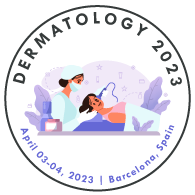
Dr. Danilo Augusto Teixeira
Assistant professor. Department of Dermatology. Hospital for Tropical Diseases, Goiânia, Brazil
Title: Ultrasound-guided hyaluronidase: the only method to solve hyaluronic acid encapsulation
Biography
Biography: Dr. Danilo Augusto Teixeira
Abstract
Summary: The encapsulation of hyuronic acid is one of the possible complications resulting from fillings performed with this substance. The present report aims to demonstrate that ultrasound-guided hyaluronidase injection is an effective method for resolving such a complication. We describe a case that illustrates the application of the ultrasound-guided technique and with that we intend to help dermatologists to reach an effective and resolute outcome in the treatment of these complications. Case report: The patient underwent 2 filling sessions with hyaluronic acid (HA) in the bilateral infraorbital region, with an interval of 6 months between them, performed by a non-medical professional. After that, the patient evolved with a complaint of edema at the filling site on the left, with consequent indication of reversal with hyaluronidase, by the same professional. However, it did not obtain satisfactory results, being referred to our service. After evaluation, a new reversal session was indicated with 800 IU local hyaluronidase, guided by ultrasound (US) and performed by cannula. However, she returned after 23 days, with the same complaint. The procedure performed with a cannula was not able to completely reverse the accumulation of hyaluronic acid. A procedure with 600 IU of hyaluronidase guided by US was again indicated, now using a 30 g needle, because in this session the presence of a pocket around the HA was evidenced, which prevented the cannula progression and correct product degradation. After the second session, there was complete resolution of the condition. Discussion: In the last decade, there has been a significant increase in the number of aesthetic procedures performed around the world. One of the most commonly performed procedures is filling with hyaluronic acid. Several complications arising from such procedures are described in the literature, such as: tissue necrosis, palpable nodules, granulomas and infections. Recently, an increase in the demand for dermatological services has been observed, the origins of the aforementioned concerns. Therefore, it became necessary to describe an effective technique for resolving hyaluronic acid encapsulation. In the case described, after application of hyaluronidase in the perilesional region, through an ultrasound-guided cannula, there was no satisfactory improvement in the condition. This is due to the presence of the so-called hyaluronic acid encapsulation, preventing penetration of the cannula and the action of hyaluronidase by contiguity. We showed that after the infiltration of intralesional hyaluronidase with a 30g needle guided by ultrasound, there was complete remission of the hyaluronic acid content. The technique described above is a highly effective method for resolving this type of complication and is easy to apply

